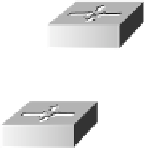Information Technology Reference
In-Depth Information
Routing Levels
DECnet routing nodes are referred to as either Level 1 or Level 2 routers. A Level 1 router communicates
with end nodes and with other Level 1 routers in a particular area. Level 2 routers communicate with
Level 1 routers in the same area and with Level 2 routers in different areas. Together, Level 1 and Level
2 routers form a hierarchical routing scheme. This relationship is illustrated in Figure 11-5.
Figure11-5
DECnet Level 1 and Level 2 Routers
Level 1
router
Level 2
router
End
system
Level 1
router
Level 2
router
Area 10
Level 2
router
Level 1
router
Level 2
router
Level 1
router
End
system
Area 5
End systems send routing requests to a designated Level 1 router. The Level 1 router with the highest
priority is elected to be the designated router. If two routers have the same priority, the one with the
larger node number becomes the designated router. A router's priority can be manually configured to
force it to become the designated router.
As shown in Figure 11-5, multiple Level 2 routers can exist in any area. When a Level 1 router wishes
to send a packet outside its area, it forwards the packet to a Level 2 router in the same area. In some
cases, the Level 2 router may not have the optimal path to the destination, but the mesh network
configuration offers a degree of fault tolerance not provided by the simple assignment of one Level 2
router per area.
The Transport Layer
The DNA transport layer is implemented by a variety of transports, both proprietary and standard. OSI
transports TP0, TP2, and TP4 are supported.
























